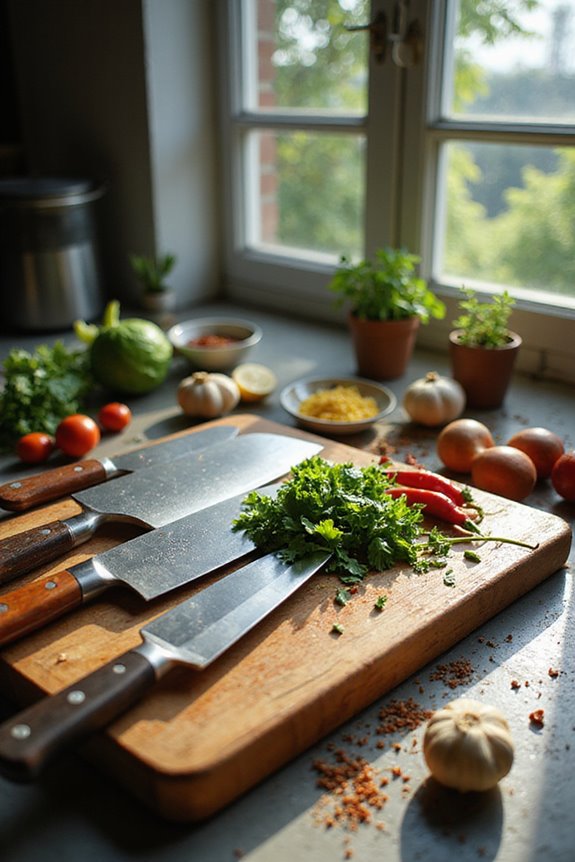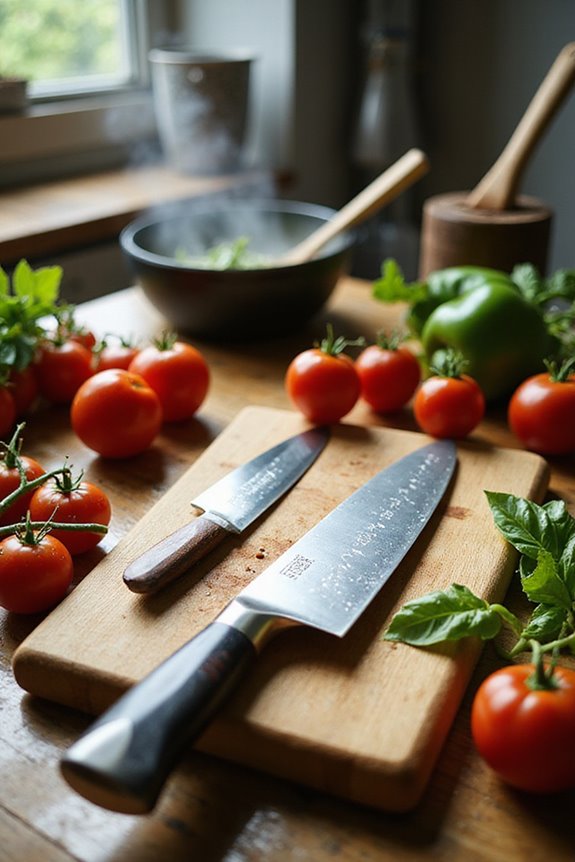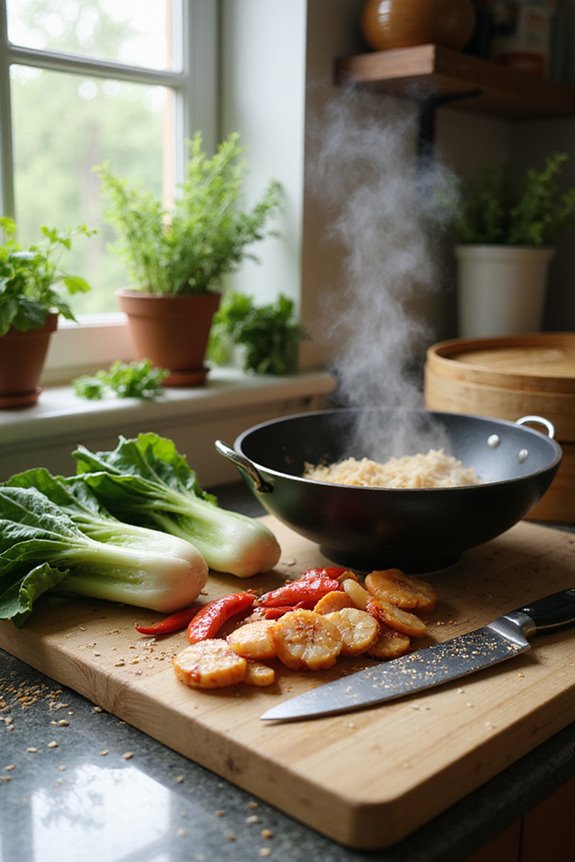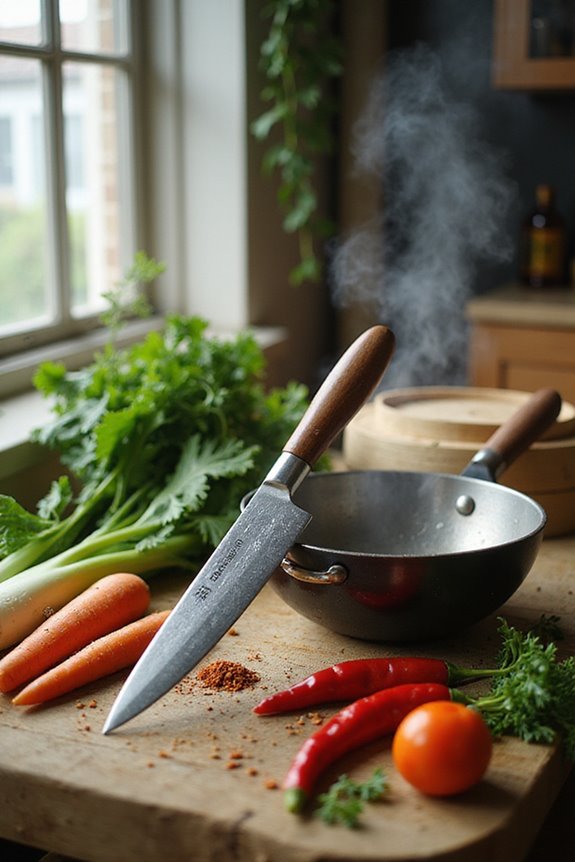As an Amazon Associate, we earn from qualifying purchases. Some links may be affiliate links at no extra cost to you. Although our opinions are based on curated research, we haven't used these products. Articles generated with AI.
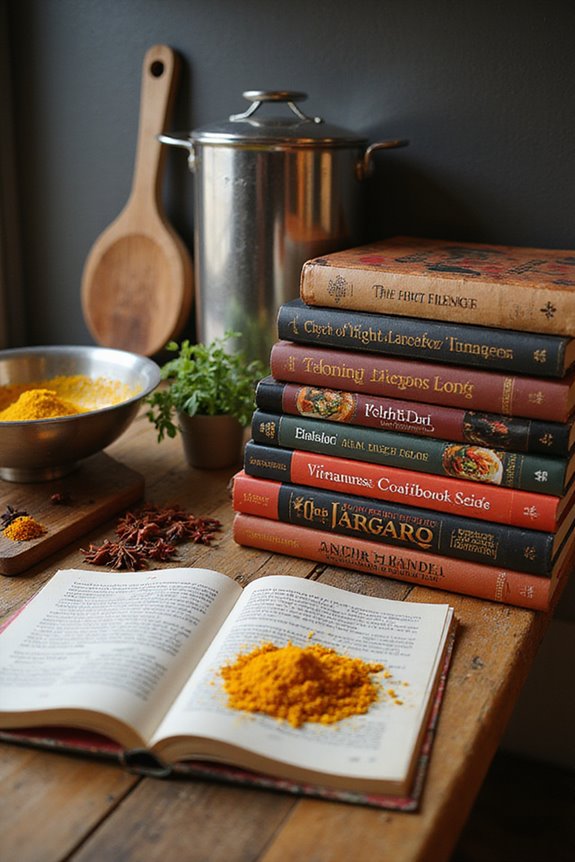
5 Best Vietnamese Cookbooks for Home Cooking: A Culinary Journey to Vietnam
If you’re looking to explore Vietnamese cuisine at home, consider these five cookbooks: *An Chua: Simple Vietnamese Recipes That Taste Like Home* offers accessible favorites; *Recipes from My Home Kitchen* mixes Asian and American comfort food; *101 Asian Dishes You Need to Cook Before You Die* showcases a variety of Asian meals; *Lemongrass, Ginger and Mint* presents authentic home cooking; and *Vietnamese Home Cooking* focuses on everyday recipes. Each book brings unique insights into culinary techniques and ingredients to enrich your cooking experience. You might be surprised by what you find next!
Key Takeaways
- An Chua: Simple Vietnamese Recipes That Taste Like Home offers user-friendly recipes and essential cooking tips, perfect for novice chefs aiming to bond through cooking.
- Lemongrass, Ginger and Mint Vietnamese Cookbook focuses on authentic home cooking with straightforward guidance and personal stories to enhance the experience.
- Vietnamese Home Cooking: [A Cookbook] organizes recipes by cooking techniques and includes beautiful photographs to encourage culinary exploration for various skill levels.
- Emphasizing ingredients’ accessibility, these cookbooks guide readers to readily available items and suggest substitutes for hard-to-find ingredients.
- Most cookbooks encourage family involvement, making them ideal for shared cooking experiences, fostering connection, and exploring rich cultural heritage.
An Chua: Simple Vietnamese Recipes That Taste Like Home
Sale
An Chua: Simple Vietnamese Recipes That Taste Like Home
- Tran, Julie Mai (Author)
- English (Publication Language)
- 192 Pages - 10/17/2023 (Publication Date) - Page Street Publishing (Publisher)
If you’re looking to immerse yourself in authentic Vietnamese cooking without feeling overwhelmed, “An Chua: Simple Vietnamese Recipes That Taste Like Home” is an excellent choice for you. This cookbook, crafted by first-generation Vietnamese author An Chua, features accessible, easy-to-follow recipes. You’ll find familiar favorites like Pho and Bun Thit Nuong, each accompanied by mouth-watering full-page color photos. The user-friendly instructions and essential cooking tips cater to novice chefs, ensuring successful outcomes. Many family cooks have found joy in preparing meals together, making it a great resource for creating lasting memories while connecting with Vietnamese heritage through food.
Best For: Home cooks looking to explore authentic Vietnamese cuisine in a user-friendly format that encourages family involvement.
Pros:
- Clear, easy-to-follow recipes suitable for novice cooks.
- Beautiful full-page photographs that make cooking visually appealing and engaging.
- Fosters family bonding through cooking and sharing of traditional meals.
Cons:
- Limited to Vietnamese cuisine, which may not satisfy those seeking a broader international cookbook.
- Some ingredients may be difficult to find in certain locations, potentially hindering recipe completion.
- May not include advanced cooking techniques for more experienced chefs looking to elevate their skills.
Recipes from My Home Kitchen: Asian and American Comfort Food Cookbook
Sale
Recipes from My Home Kitchen: Asian and American Comfort Food from the Winner of MasterChef Season 3...
- Hardcover Book
- Ha, Christine (Author)
- English (Publication Language)
“Recipes from My Home Kitchen: Asian and American Comfort Food Cookbook” is perfect for home cooks who seek a seamless blend of familiar flavors and innovative dishes. Authored by Christine Ha, a MasterChef winner, this cookbook features eight chapters filled with diverse recipes. You’ll find comfort classics like Buttermilk Fried Chicken and Chicken Pot Pie alongside Asian-inspired dishes. Christine shares her cooking journey, emphasizing her adaptation techniques that make it easy for cooks of any skill level to follow. With helpful tips on ingredients and preparation, this cookbook invites you to personalize each meal, ensuring every dish reflects your unique taste and style.
Best For: Home cooks looking to explore a mix of Asian and American comfort food with accessible recipes and personal stories.
Pros:
- Combines diverse flavors from both Asian and American cuisines.
- Offers insightful cooking techniques and adaptability tips for various skill levels.
- Personal anecdotes from Christine Ha add an engaging narrative to the cooking experience.
Cons:
- Limited recipes may not suit those seeking extensive or gourmet options.
- Some cooks might find it challenging to follow without visual cues due to Christine’s unique background.
- The focus on comfort food may not appeal to those looking for healthy or low-calorie alternatives.
101 Asian Dishes You Need to Cook Before You Die
Sale
101 Asian Dishes You Need to Cook Before You Die: Discover a New World of Flavors in Authentic...
- Tila, Jet (Author)
- English (Publication Language)
- 192 Pages - 06/27/2017 (Publication Date) - Page Street Publishing (Publisher)
For anyone enthusiastic to explore the vibrant world of Asian cuisine, “Vietnamese Cookbooks for Home Cooking” stands out as an invaluable resource. In “101 Asian Dishes You Need to Cook Before You Die,” Jet Tila presents a multitude of recipes spanning Thai, Chinese, Korean, Japanese, Vietnamese, and Indian dishes. These recipes are user-friendly, featuring accessible ingredients, which makes cooking enjoyable for everyone, from novices to experts. Many reviewers find success with dishes like Pad Thai and spring rolls, praising the clear instructions. This cookbook is not only a great addition to your collection but also a thoughtful gift for aspiring chefs.
Best For: Home cooks of all skill levels who want to explore and enjoy authentic Asian cuisine with accessible recipes.
Pros:
- User-Friendly Recipes: Easy to follow with clear instructions, making it suitable for novices and seasoned cooks alike.
- Accessible Ingredients: Utilizes common ingredients found in most grocery stores or Asian markets, eliminating the need for special sourcing.
- Culinary Variety: Covers a wide range of Asian cuisines, providing diverse options for home cooks to enjoy.
Cons:
- Limited Photos: Some reviewers wish for more visuals to enhance the cooking experience and help with presentation.
- Paperback Durability: Feedback indicates a desire for a hardcover version for greater durability over time.
- Personal Taste Variation: While many recipes are praised, taste preferences may vary, and not every dish will appeal to everyone.
Lemongrass, Ginger and Mint Vietnamese Cookbook
Sale
Lemongrass, Ginger and Mint Vietnamese Cookbook: Classic Vietnamese Street Food Made at Home
- Nguyen, Linh (Author)
- English (Publication Language)
- 208 Pages - 05/09/2017 (Publication Date) - Callisto (Publisher)
The “Lemongrass, Ginger and Mint Vietnamese Cookbook” stands out as an excellent choice for anyone enthusiastic to immerse themselves in authentic Vietnamese home cooking, especially if you’re seeking straightforward guidance and cultural insights. Linh shares her personal story, diving into the significance of key ingredients and dishes, making the recipes relatable. Each recipe is structured with easy instructions, insightful anecdotes, and Vietnamese terms, enhancing your culinary journey. While the variety caters to various seasons, the lack of photos might challenge beginners. Still, this cookbook remains a practical, valuable resource for exploring the flavors of Vietnam in your kitchen.
Best For: Anyone interested in exploring authentic Vietnamese cuisine with straightforward guidance and cultural insights.
Pros:
- Offers easy-to-follow recipes with personal anecdotes that enhance the cooking experience.
- Features a diverse range of dishes suitable for different seasons and meal plans.
- Provides valuable insights into Vietnamese culture and cuisine, making it relatable for readers.
Cons:
- Lacks photographs for most dishes, which may be challenging for those unfamiliar with Vietnamese cuisine.
- Some readers may feel bias toward northern pho, with limited representation of southern pho recipes.
- The simple presentation may not appeal to those looking for a visually striking cookbook.
Vietnamese Home Cooking: [A Cookbook]
Sale
Vietnamese Home Cooking: [A Cookbook]
- Used Book in Good Condition
- Hardcover Book
- Phan, Charles (Author)
If you’re enthusiastic to explore the rich flavors of Vietnamese cuisine but feel intimidated by unfamiliar ingredients, “Vietnamese Home Cooking” is tailored for you. Chef Phan’s cookbook serves as a reliable guide for culinary adventurers, presenting everyday dishes with a focus on cooking techniques. Recipes are neatly organized by methods like grilling, frying, and steaming, enabling you to choose what fits your skills. With beautiful photographs and a helpful glossary, this visually appealing book simplifies ingredient identification. While some recipes can be complex, you’re encouraged to adapt and practice, making each dish uniquely yours. Immerse yourself, and enjoy the journey!
Best For: This cookbook is best for home cooks eager to delve into Vietnamese cuisine while learning essential cooking techniques.
Pros:
- Well-structured recipes organized by cooking techniques make it easy to navigate.
- Beautifully photographed pages create an appealing and inspiring cooking experience.
- Personal insights from Chef Phan offer relatable guidance that enhances the reader’s connection to the recipes.
Cons:
- Some recipes may be ingredient- and labor-intensive, requiring significant time and effort.
- Complexity in certain steps may confuse beginners or those unfamiliar with Vietnamese cooking.
- Limited access to well-stocked Asian grocery stores may pose challenges for some readers.
Factors to Consider When Choosing Vietnamese Cookbook Home Cooking
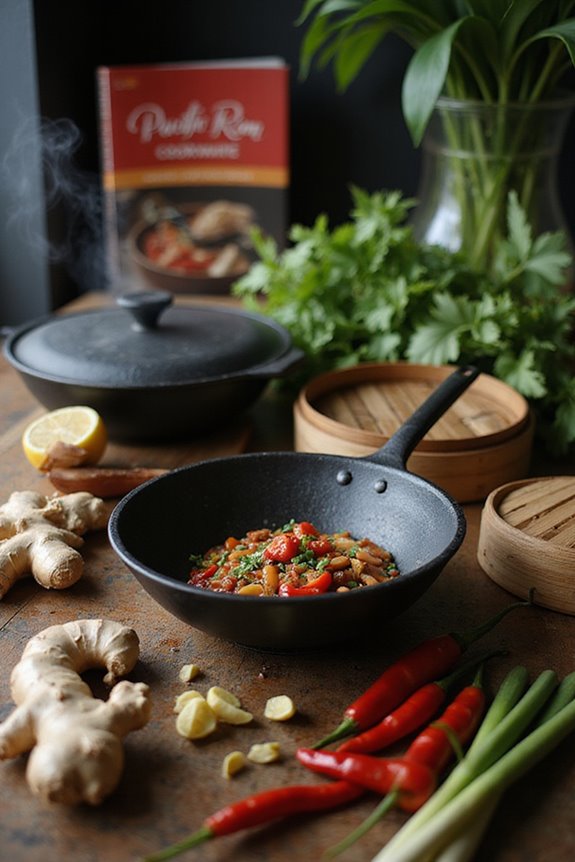
When you’re choosing a Vietnamese cookbook for home cooking, think about a few important factors. You’ll want to guarantee the recipes are authentic and that the ingredients are easy to find at your local market. Also, consider how well the book presents cooking techniques and offers chances for family involvement; these elements can really enhance your cooking experience.
Authenticity of Recipes
Choosing an authentic Vietnamese cookbook involves more than just selecting recipes; it’s about connecting with the rich culinary heritage of Vietnam. Look for cookbooks that include personal anecdotes and cultural insights, as these elements enhance your cooking experience and connection to the dishes. Authentic recipes should evoke traditional flavors and techniques, allowing you to recreate genuine Vietnamese cuisine. Additionally, pay attention to the ingredients recommended; sticking with readily available components keeps the cooking process accessible. Opt for books that categorize recipes by cooking techniques to better understand traditional methods. This structured approach, combined with an emphasis on authenticity, will enrich your culinary journey as you plunge into the vibrant world of Vietnamese cooking.
Visual Appeal and Layout
A visually appealing Vietnamese cookbook can transform your cooking experience, making it not just about following recipes but also about savoring the art of preparation. Look for books that feature mouth-watering photographs to entice you into trying new dishes, enhancing your overall culinary adventure. A well-organized layout lets you navigate recipes easily, ensuring you can quickly find specific dishes or ingredients. Clear presentation of recipes with ingredient lists and step-by-step instructions will cater to cooks of all skill levels. Additionally, visual elements like glossaries with illustrations can help you identify ingredients commonly found in Asian grocery stores. An engaging format, rich with personal anecdotes and cultural insights, connects you deeper to the recipes and the vibrant cuisine of Vietnam.
Accessibility of Ingredients
Selecting a Vietnamese cookbook often means considering the availability of ingredients used in the recipes. It’s essential to guarantee that the ingredients can be found easily in your local grocery stores or Asian markets, as this accessibility greatly influences your cooking success. Some cookbooks simplify the process by avoiding rare ingredients, making it easier for you to recreate authentic dishes without sourcing headaches. Look for books that suggest common substitutes for hard-to-find items, expanding your culinary options. Many also include sections on pantry staples important to Vietnamese cuisine, helping you stock your kitchen efficiently. Additionally, clear ingredient lists and instructions can make finding and using the necessary components much smoother, enhancing your overall cooking experience.
Cooking Techniques Offered
Mastering Vietnamese cuisine involves more than just following recipes; it requires understanding the cooking techniques that bring dishes to life. Look for cookbooks that categorize recipes by techniques like steaming, frying, braising, grilling, and stir-frying. This organization helps you focus on mastering each method. Choose books with clear instructions and practical approaches, enhancing your ability to prepare authentic dishes. A glossary of ingredients and cooking tools makes learning easier and your cooking experience more enjoyable. Additionally, consider resources that explain the cultural significance of these techniques, providing deeper insights. It’s also beneficial if the cookbook encourages flexibility, allowing you to adapt recipes based on your palate and what you have on hand.
Family Involvement Opportunities
Exploring cookbooks that prioritize family involvement can turn cooking into a fun, collaborative experience in your kitchen. Choose a cookbook that encourages all family members to participate, as many have found joy in recreating favorites together. Visually appealing images are key; colorful photographs can excite young cooks and inspire their creativity. Look for user-friendly recipes with clear, easy-to-follow instructions, ensuring cooks of all ages can join in. Additionally, consider cookbooks that feature a variety of dishes to cater to different tastes and preferences, allowing everyone to enjoy the process. Finally, those that share cultural insights can stimulate enriching discussions about heritage and traditions, making cooking an even more rewarding and engaging activity for your family.
Personal Stories Included
When diving into the world of Vietnamese cookbooks, consider those that weave personal stories and anecdotes into their pages. These narratives provide essential context and cultural insights, enriching your cooking experience. They often reflect the author’s family traditions and childhood memories, fostering a deeper connection to the dishes you’ll prepare. By sharing personal experiences, authors make their cookbooks more relatable, allowing you to understand the significance of specific ingredients and cooking methods in Vietnamese culture. These stories not only inspire you to recreate family memories but also encourage you to explore your culinary heritage. Ultimately, the integration of personal anecdotes enhances the cookbook’s narrative, making it even more engaging and enjoyable for home cooks at any skill level.
Variety of Dishes
Many home cooks appreciate the rich cultural narratives found in Vietnamese cookbooks, but the variety of dishes offered is equally important when choosing the right one. A good cookbook should present a diverse array of staples like Pho and Banh Mi, ensuring a thorough cooking experience. Look for recipes categorized by techniques such as steaming and grilling, which help you explore different cooking methods. Including condiments and pickles enhances traditional flavors, making your meals come alive. Additionally, a range of vegetarian and seafood recipes caters to various dietary preferences, widening its accessibility. Seasonal recipes allow you to utilize fresh ingredients, ensuring your meals are aligned with what’s available locally, and fostering creativity in meal planning.
User-Friendly Instructions
A well-chosen Vietnamese cookbook makes your cooking journey smoother and more enjoyable, especially if it offers clear, easy-to-follow instructions. Look for cookbooks that detail ingredients and methods, as these can greatly enhance your culinary experience, whether you’re a beginner or seasoned cook. User-friendly recipes often include specific cooking tips that build your confidence in the kitchen. Explore cookbooks organized by cooking techniques, making it simpler to understand how to execute each dish. Additionally, check for sections outlining pantry staples, which aid meal planning and shopping. Full-page color photos alongside recipes not only add visual appeal but also serve as a motivating reference to inspire you to try new dishes and improve your cooking skills.
Frequently Asked Questions
What Essential Ingredients Are Popular in Vietnamese Cooking?
In Vietnamese cooking, essential ingredients include fish sauce, which adds depth to dishes, and rice noodles, a staple for many meals. Fresh herbs like cilantro and mint bring vibrant flavor, while lemongrass imparts a citrusy aroma. You’ll also find tamarind for its tangy kick and chili peppers for heat. Don’t forget fresh vegetables like bean sprouts, as they add crunch and nutrition, making your meals bright and balanced. Enjoy the rich diversity!
How Can I Adapt Vietnamese Recipes for Dietary Restrictions?
Imagine crafting a vibrant dish, where flavors dance like sunlight on water. To adapt Vietnamese recipes for dietary restrictions, start by identifying the core ingredients. Swap fish sauce with soy sauce for a vegan option, or use coconut aminos for a gluten-free alternative. Substitute rice noodles with zucchini noodles for a low-carb twist. Always keep the balance of flavors in mind, ensuring your dish retains its essence, while catering to specific needs seamlessly.
Are There Vegetarian Options in Vietnamese Cuisine?
Yes, there are plenty of vegetarian options in Vietnamese cuisine! Dishes like vegetable pho, banh xeo (Vietnamese pancakes), and fresh spring rolls can easily be made without meat. You’ll find tofu as a common protein substitute that absorbs delicious flavors. Many street vendors and restaurants offer vegetarian versions, so don’t hesitate to ask. Additionally, incorporating local herbs and vegetables can elevate your cooking while keeping it meat-free and tasty. Enjoy exploring!
What Cooking Tools Are Necessary for Vietnamese Recipes?
When diving into Vietnamese cooking, you’ll need some essential tools. A sharp chef’s knife is vital for chopping herbs and vegetables. Don’t forget a bamboo steamer for preparing delicate dumplings. A mortar and pestle will help you create sauces and pastes, while a rice cooker makes perfectly fluffy rice a breeze. Finally, grab a frying pan or wok for those sizzling stir-fries. These tools will set you on the right culinary path for success!
How Do I Store Leftover Vietnamese Dishes Properly?
To store leftover Vietnamese dishes, let them cool at room temperature for about 30 minutes, but don’t leave them out for too long. Use airtight containers for storage, ensuring you separate any sauces or broths to prevent sogginess. Label each container with the date, and keep them in the fridge for up to four days. For longer storage, consider freezing. Just remember to thaw them in the fridge before reheating for best results.





![Vietnamese Home Cooking: [A Cookbook]](https://m.media-amazon.com/images/I/51TZB5G+Z1L.jpg)
